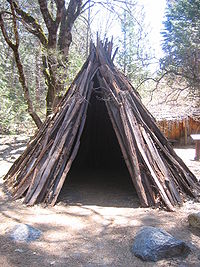Miwuk
 |
|
| Total population | |
|---|---|
| (1770: over 11,000 1910: 670 1930: 491 current: 3,500) |
|
| Regions with significant populations | |
| California: Sierra Nevada Mountains, Central Valley, Marin County, Sonoma County, Lake County, Contra Costa County | |
| Languages | |
|
Utian languages: Miwok family |
|
| Religion | |
|
Shamanism: Kuksu Miwok mythology |
|
| Related ethnic groups | |
|
Subgroups: |
Subgroups:
The Miwok (also spelled Miwuk, Mi-Wuk, or Me-Wuk) are members of four linguistically related Native American groups indigenous to what is now Northern California, who traditionally spoke one of the Miwok languages in the Utian family. The word Miwok means people in their native language.
Anthropologists commonly divide the Miwok into four geographically and culturally diverse ethnic subgroups. These distinctions were unknown among the Miwok before European contact.
The United States Bureau of Indian Affairs officially recognizes eleven tribes of Miwok descent in California. They are as follows:
The predominant theory regarding the settlement of the Americas date the original migrations from Asia to around 20,000 years ago across the Bering Strait land bridge, but one anthropologist claims that the Miwok and some other northern California tribes descend from Siberians who arrived in California by sea around 3,000 years ago.
The Miwok lived in small bands without centralized political authority before contact with European Americans in 1769. They had domesticated dogs and cultivated tobacco, but were otherwise hunter-gatherers.
The Sierra Miwok harvested acorns from the California Black Oak. In fact, the modern-day extent of the California Black Oak forests in some areas of Yosemite National Park is partially due to cultivation by Miwok tribes. They burned understory vegetation to reduce the fraction of Ponderosa Pine. Nearly every other kind of edible vegetable matter was used as a food source, including bulbs, seeds, and fungi. Animals were hunted with arrows, clubs or snares, depending on the species and the situation. Grasshoppers were a highly prized food source, as were mussels for those groups adjacent to the Stanislaus River.
...
Wikipedia
